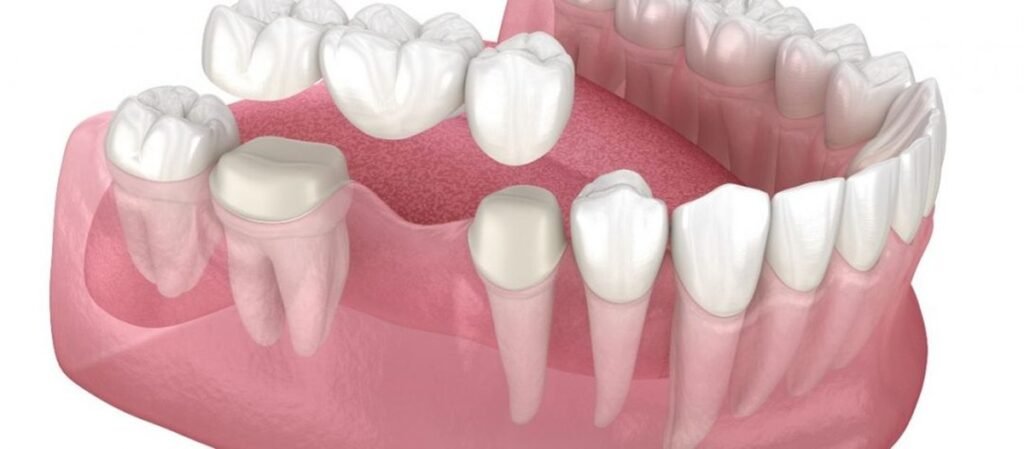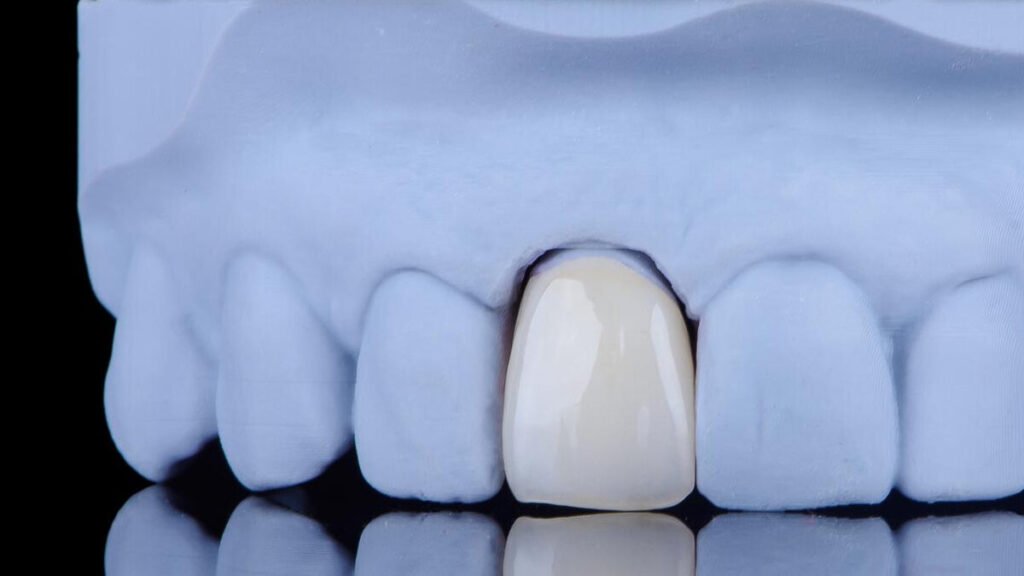
Dental bridges are a time-tested solution for replacing missing teeth and restoring function and aesthetics. Thanks to advances in digital dentistry and innovative materials, dental bridges are more precise and durable than ever.
This guide provides all the essential information you need, whether you’re a dental professional or a patient seeking to understand your treatment options.
What Are Dental Bridges?
Dental bridges are fixed prosthetic devices that replace one or more missing teeth by anchoring them to adjacent healthy teeth or dental implants. They help restore chewing function, maintain the shape of your face, and prevent the shifting of remaining teeth.
Digital technology has greatly enhanced the design and fabricating of dental bridges in modern dentistry. High-precision materials like Aidite Dental Model Resin (Yellow) enable dental professionals to create accurate, durable models critical for successful restorations.
Types of Dental Bridges
Dental bridges come in several varieties, each with its indications and benefits:
1. Traditional Dental Bridges
Traditional bridges are the most common type and consist of one or more points (replacement teeth) suspended between two crowns cemented onto adjacent natural teeth. They are ideal when healthy teeth are on either side of the gap.
2. Maryland Bridges
Maryland or resin-bonded bridges use a metal or porcelain framework bonded to the back of the adjacent teeth. They are less invasive than traditional bridges, as they typically require minimal tooth preparation, making them a conservative option for certain cases.
3. Implant-Supported Bridges
Implant-supported bridges offer a robust and long-lasting solution when multiple teeth are missing. These bridges are anchored on dental implants rather than natural teeth, providing improved stability and function, especially in cases where natural abutment teeth are not available
What Are Dental Bridges Procedures?

Creating a dental bridge involves several critical steps that ensure a precise fit and long-term success:
1. Consultation
- Diagnosis and Planning: The process begins with a thorough dental examination, radiographs, and sometimes digital scans. This evaluation determines whether a dental bridge is the appropriate treatment.
- Treatment Options: Your dentist will discuss different types of bridges (traditional, Maryland, implant-supported) and recommend the best option based on your oral health and needs.
2. Preparation
- Tooth Preparation: Traditional bridges require the abutment teeth (the teeth on either side of the gap) to be shaped to receive crowns. Maryland bridges require minimal preparation.
- Temporary Restorations: Temporary bridges may be placed to protect prepared teeth while the final bridge is fabricated.
3. Impression
- Digital Scanning: Modern practices often use digital impressions, which capture teeth’ precise shape and structure. This digital data is essential for designing a highly accurate restoration.
- Aidite Dental Model Resin (Yellow): For clinics using 3D printing technology, Aidite Dental Model Resin (Yellow) is a preferred material due to its high hardness, dimensional stability, and ability to capture fine details. It ensures that the final model used to fabricate your bridge is accurate, leading to better fit and function.
4. Placement
- Fabrication: The final bridge is constructed in a dental lab using a digital or conventional impression. Depending on the type of bridge, the materials may include porcelain, metal, or zirconia,
- Cementation: Once the bridge is ready, it is carefully fitted, adjusted for occlusion, and permanently cemented into place using high-quality resin-based cement.
Dental Bridge Cost: What to Expect
Costs vary based on materials, type, and complexity:
- Traditional Bridges: 2,000–5,000 per unit.
- Maryland Bridges: 3,000–6,000 per implant.
Insurance often covers 50–80% of traditional bridge costs.
How Long Does a Dental Bridge Last?
With proper care, bridges typically last 7–15 years. Factors influencing longevity:
- Oral Hygiene: Brush, floss, and use antiseptic mouthwash daily.
- Diet: Avoid hard/sticky foods to prevent damage.
- Check-Ups: Regular visits detect issues early.
Bridges vs. Implants: Key Differences
Two popular options for replacing missing teeth are dental bridges and dental implants. Each has advantages, depending on cost, longevity, and procedure complexity.
Below is a detailed comparison to help you decide which option suits you best.
1. Cost Comparison
Dental Bridges: $1,500–$5,000
Dental Implants: $3,000–$6,000 per implant
- Bridges are generally more affordable upfront, making them a preferred choice for budget-conscious patients.
- Although more expensive initially, implants provide a longer-lasting solution and may save money over time by reducing the need for replacements.
- Insurance Coverage: Many dental plans cover bridges but may offer limited or no coverage for implants.
2. Procedure & Healing Time
Dental Bridges
- It is less invasive and requires 2–3 visits over a few weeks.
- The adjacent teeth are filed down to support the bridge.
- Once the custom bridge is ready, it is cemented in place.
Dental Implants
- Surgical procedure requiring 3–6 months of healing.
- A titanium post is surgically placed into the jawbone to act as an artificial root.
- After healing, a custom crown is attached to complete the restoration.
3. Lifespan & Durability
Dental Bridges: Last 7–15 years, but may require replacement due to wear or damage.
Dental Implants: For the last 20+ years, they have often been a permanent solution with proper care.
- Implants are made of titanium, which integrates with the jawbone, making them stronger and more durable.
- Bridges rely on adjacent teeth, which may weaken over time and require additional dental work.
4. Bone Preservation & Oral Health
Dental Bridges:
- Do not prevent jawbone loss after tooth extraction.
- Since they rely on adjacent teeth, those teeth may weaken over time.
Dental Implants:
- Stimulate bone growth and prevent jawbone deterioration.
- Function like natural tooth roots, maintaining facial structure and oral health.
How Aidite Dental Bridges Products Enhance Treatment Outcomes?
Aidite’s advanced dental solutions streamline the creation of durable, aesthetic bridges, combining precision engineering with innovative materials. Below is an overview of how their flagship products support dental bridge treatments:
1. Aidite AMM-580 Implant Milling Machine

The AMM-580 Dental Milling Machine’s ability to produce implant bars and screw-retained bridges with micron-level precision ensures seamless fit and long-term stability. Its compatibility with titanium and cobalt chrome makes it a go-to for high-stress posterior bridges.
Key Specifications & Benefits
- 5-Axis Precision: Enables complex geometries for implant bars, screw-retained bridges, and custom abutments with ±5µm repeat accuracy.
- Material Versatility: Mills titanium, cobalt chrome, glass ceramic, PEEK, and PMMA, accommodating diverse clinical needs.
- High-Speed Spindle: The 60,000 RPM spindle, with water cooling, ensures smooth, precise cuts even for dense materials like zirconia.
- Wide Processing Range: This machine handles materials up to 25mm thick and fixtures of 98mm blocks, making it ideal for multi-unit bridges.
- Tool Management: a 25-tool magazine with real-time usage tracking reduces downtime and errors.
2. Aidite AiZir Flash Zirconia

AIZIR Flash Zirconia Material’s combination of speed and durability allows labs to deliver full-arch bridges with lifelike aesthetics and fracture resistance, reducing remakes and patient wait times.
Key Specifications & Benefits
- Rapid Sintering achieves full density in 30 minutes (vs. 690 minutes for conventional sintering), making it ideal for same-day restorations.
- Strength & Aesthetics: Flexural strength of 1,250 MPa and 48% translucency mimic natural enamel, suitable for anterior and posterior bridges.
- Multi-Unit Compatibility: Supports up to 12-unit bridges with consistent sintering results across a wide temperature range (1,530–1,570°C).
- Vita Shade Matching: 16 Vita shades ensure seamless integration with adjacent teeth.
3. Aidite CPD-100 Dental Milling Machine

The Aidite CPD-100 DLP 3D Printer is a high-performance milling and printing solution for oral restoration and dental implants. Its advanced AI optimization technology ensures high-precision printing for guide plates, veneers, single crowns, and bridges.
Key Features & Advantages
- High-Speed 3D Printing: The CPD-100 utilizes AI optimization technology, allowing for a 26mm/h high-speed printing rate with a 0.05mm layer thickness. This significantly reduces molding time while maintaining accuracy.
- Exceptional Precision: With a 30μm accuracy and 75μm XY resolution, the CPD-100 ensures fine details in veneers, crowns, and implant guides, making it a reliable choice for complex dental restorations.
- Material Versatility: Expected to be compatible with various materials, including zirconia, PMMA, and ceramics, allowing flexibility for diverse dental applications.
- User-Friendly Operation: The machine offers print preview functionality and LAN-shared print file access, making it easy to operate and manage prints remotely.
FAQs
Q1: What are dental bridges, and how do they work?
A dental bridge is a fixed prosthetic device that replaces one or more missing teeth by anchoring to adjacent teeth or implants. They restore function and aesthetics by filling the gap with a prosthetic tooth (pontic) supported by crowns on either side.
Q2: What types of dental bridges are available?
The main types are traditional dental bridges, Maryland (resin-bonded), and implant-supported ones. Each type is chosen based on the specific clinical situation and patient needs.
Q3: How does digital dentistry improve dental bridge fabrication?
Digital impressions and 3D printing enable the creation of highly accurate dental models. Aidite Dental Bridges Materials enhance precision, ensuring the final bridge fits perfectly.
Q4: What is the recovery process like after dental bridge placement?
Recovery is typically straightforward, with most patients experiencing minimal discomfort. Good oral hygiene and regular dental check-ups are essential for long-term success.
Q5: How do I choose between a dental bridge and dental implants?
The choice depends on factors such as overall oral health, the condition of adjacent teeth, cost, and patient preference. Dental bridges are less invasive and more cost-effective, while implants offer a more permanent solution without relying on adjacent teeth.
Conclusion
Dental bridges remain a cornerstone of restorative dentistry, offering aesthetic and functional benefits. Dental professionals can achieve exceptional outcomes by understanding the various types, procedures, and aftercare practices. Advanced Aidite materials further enhance the precision and reliability of dental restorations, making them an indispensable tool in modern digital dentistry.
Whether you opt for a traditional bridged bridge or an implant-supported solution, informed decision-making and meticulous care will ensure your patients enjoy healthy, beautiful smiles for years.



